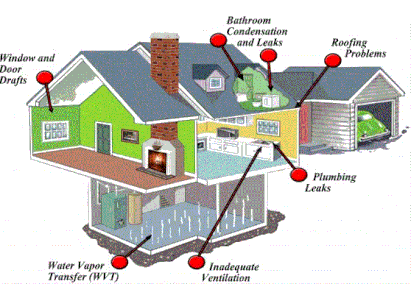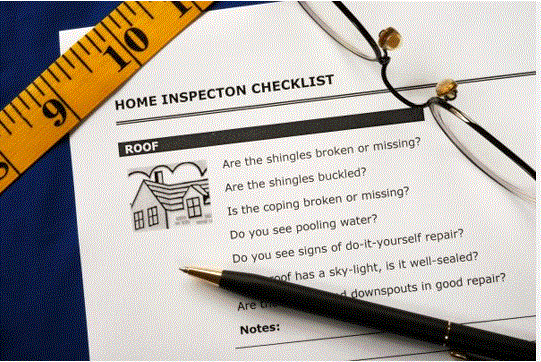 An important part of the process is the home inspection where a professional makes sure everything in the house is functioning properly and identifies needed repairs. Here are a few reasons why you don’t want to skip over this step. The home-buying process is long and arduous. You often spend months searching for the right home before you make an offer and once an offer is made and accepted, you must jump through several more hoops before the sale closes. An important part of the process is the home inspection where a professional makes sure everything in the house is functioning properly and identifies needed repairs. The buyer pays the cost of a home inspection but can always wave the right to an inspection. That’s not a good idea. You should make a home inspection a mandatory part of the home-buying process. “You need unbiased documentation of the home’s condition,” said April Leslie, a radon measurement and home inspection specialist at Award Home Inspections in Richmond, Virginia. This goes for both the purchase of a pre-owned home as well as new construction. Unseen and Unpredicted Problems You can fall in love with a home for various reasons. You might love the size of the home, the open floor plan, the home’s exterior or the layout of the kitchen. While the home may look to be in excellent shape, the home’s aesthetics can hide real problems. You need an inspector to climb into the attic and inch around in the crawl space. The inspector can discover real and expensive problems that are not always apparent when you view the home with a real estate agent. “The home might not look good on top and underneath,” Leslie said. “It’s much more than the red door curb appeal. A great home is more interior decorating and a good paint job. It’s about what’s in your walls and not what’s on them.” More Options When you and the seller reach an agreement on the home, you are under some legal obligation to finalize the sale. A home inspection gives you ways to get out of the deal. Once the home inspector completes a report, you can renegotiate with the seller. You might want to have certain items repaired, or you could seek to have the cost of the home reduced. If an agreement is not reached on the items in the report, you can back out of the deal. A recent survey by the National Association of Realtors found that 14% of sales are never finalized due to the home inspection, the third largest reason. “It’s going to educate you about one of your greatest purchases,” Leslie said. “You are also learning very practical information about the home like where the main water shutoff valve is located and where the main fuel shutoff is.” Cost Efficient Cost is not an inhibiting factor for a home inspection. An inspection on a condominium can be as little as $300 while the cost of a single-family home inspection ranges from $350 to $500. Specialized radon and HVAC inspections add a little bit more to the cost. In the end, the money is worth the investment. A quality home inspection can keep you from having to pay tens of thousands of dollars in repairs costs. “You will always benefit more than the cost of your home inspection,” April said. Structural Problems The home inspector will look at the foundation and other structural elements of the house. If the house is not structurally sound, the inspection report will identify the problems. Structural problems are major red flags when buying a house. You don’t want to get stuck with a home that is not well built. Leaks A new roof can cost $10,000 or more to replace and is one of the more expensive maintenance costs of owning a home. The inspector will look at the roof and identify the roof’s age in order to decide whether it is in proper working order. The report will point out any problems with the roof. Safety An important part of the home inspection is to make sure the home is safe. The inspector will look at the electrical system and make sure it is in proper working order. You don’t want to live in a home with an unsafe electrical system. If you choose to get a radon test, you will understand if the radon levels in the house are at safe levels. Radon is an odorless gas that can cause lung disease. Maintenance Costs A home requires ongoing maintenance. Things wear out and break. When putting together a budget for buying a home, you need to include maintenance costs. The amount of money that you budget will depend on the home’s condition. A newer home is less likely to need maintenance than an older home. “Most inspection reports include the cost of deferred maintenance,” Leslie said. “These are things that will have pending replacements in the next five years.” Negotiation Leverage You have a huge amount of leverage with an inspection report. You can ask the seller to fix the problems in the report, renegotiate the asking price or ask the seller to contribute more to the closing costs. You are in the driver’s seat if the inspection report shows major problems with the house. Peace of Mind An inspection report guarantees that you understand the condition of the home when the sale finalizes which can ultimately bring you peace of mind. All in all, you don’t want any major surprises shortly after moving into your new home. “Peace of mind can’t be overrated,” Leslie said. “You have actual physical documentation that informs you of the condition of the home. This is true even on new construction. For example, the air ducts could not be placed correctly.” JAMES SHEA See more posts by this author
1 Comment
Indoor air quality is generally worse than most people believe, but there are things you can do about it. Some Quick Facts:
Signs of indoor air quality problems include:
Common Sources of Air Quality Problems Poor indoor air quality can arise from many sources. At least some of the following contaminants can be found in almost any home:
Remedies to Indoor Air Quality Problems Living Areas Paneling, pressed-wood furniture, and cabinetry may release formaldehyde gas. Remedy: Ask about formaldehyde content before buying furniture and cabinets. Some types of pressed-wood products, such as those with phenol resin, emit less formaldehyde. Also, products coated with polyurethane or laminates may reduce formaldehyde emissions. After installation, open windows. Maintain moderate temperature and humidity. Biological pollutants can grow on water-damaged carpet. New carpet can release organic gases. Remedy: Promptly clean and dry water-damaged carpet, or remove it altogether. If adhesives are needed, ask for low-emitting ones. During installation, open doors and windows, and use window fans or room air conditioners. Vacuum regularly. Consider area rugs instead of wall-to-wall carpet. Rugs are easier to remove and clean, and the floor underneath can also be cleaned. Some floor tiles contain asbestos. Remedy: Periodically inspect for damage or deterioration. Do not cut, rip, sand or remove any asbestos-containing materials. If you plan to make changes that might disturb the asbestos, or if materials are more than slightly damaged, contact a professional for repair or removal. Call your local or state health department or the Environmental Protection Agency. Moisture encourages biological pollutants including allergens, such as mold, mildew, dust mites and cockroaches. Remedy: If possible, eliminate moisture sources. Install and use exhaust fans. Use a dehumidifier, if necessary. Remove molds and mildew by cleaning with a solution of chlorine bleach (1 cup bleach to 1 gallon water). Maintain fresh air with natural and mechanical air circulation. Your fireplace can be a source of carbon monoxide and combustion pollutants. Remedy: Open the flue when using the fireplace. Have the flue and chimney inspected annually for exhaust back-drafting, flue obstructions, cracks, excess creosote, and other damage. Install smoke and carbon monoxide detectors. An air conditioner can be a source of biological allergens. Remedy: If there is a water tray, empty and clean it often. Follow all service and maintenance procedures, including changing the filter. Gas and kerosene space heaters can release carbon monoxide and combustion pollutants. Remedy: Never use unvented kerosene or gas space heaters. In the room where the heater is located, provide fresh air by opening a door to the rest of the house, turning on an exhaust fan, and slightly opening a window. Tobacco smoke contains harmful combustion and particulate pollutants, including carbon monoxide and combustion byproducts. Remedy: Do not smoke in your home or permit others to do so, especially near children. If smoking cannot be avoided indoors, open windows and use exhaust fans. New draperies may be treated with a formaldehyde-based finish and emit odors for a short time. Remedy: Before hanging, air draperies to ventilate odors. After hanging, ventilate the area. Maintain moderate temperature and humidity. Paint manufactured before l978 may contain lead. Remedy: Leave lead-based paint undisturbed if it is in good condition. Before removing paint, test for lead. Do-it-yourself lead test kits are available from hardware and building supply stores. Do not sand, burn off or remove lead-based paint yourself. Hire a person with special training to correct lead-based paint problems. For more information, call 1-800-LEAD-FYI. Many animals create airborne allergens, such as dander, hair, feathers and skin. Remedy: Keep pets outdoors as much as possible. Clean the entire house regularly. Deep-clean areas where pets are permitted. Bathe pets regularly. Biological allergens caused by dust mites can trigger asthma. Remedy: Clean and vacuum regularly. Wash bedding in water hotter than 130 degrees F. Use more hard-surface finishes; they are less likely to attract and hold dust mites. Kitchen Unhealthy and irritating vapors may be released from chemicals in household cleaners and similar products. Remedy: Select nonaerosol and non-toxic products. Use, apply, store and dispose of them according to manufacturers' directions. If products are concentrated, label the storage container with dilution instructions. Use up a product completely before discarding its container. Pressed-wood cabinets can be a source of formaldehyde vapor. Remedy: Maintain moderate temperatures (80 degrees maximum) and humidity (about 45%). When purchasing new cabinets, select solid wood or metal cabinets, or those made with phenol resin; they emit less formaldehyde. Ventilate well after installation. Unvented gas stoves and ranges are sources of carbon monoxide and combustion byproducts. Remedy: Keep appliance burners clean. Have burners periodically adjusted (blue-flame tip, not yellow). Install and use an exhaust fan. Never use a gas range or stove to heat your home. Bathroom Organic gases are released from chemicals in some personal care products, such as deodorant, hair spray, shampoo, toner, nail polish and perfumes. Remedy: Select odor-free or low odor-producing products. Select nonaerosol varieties. Open a window, or use an exhaust fan. Follow manufacturers' directions when using the product and disposing of containers. Air fresheners can release organic gases. Remedy: Open a window or use the exhaust fan. Follow manufacturers' directions. Select natural products. Bedroom Humidifiers and cold-mist vaporizers can encourage biological allergens, including mold, mildew and cockroaches, that can trigger asthma, and encourage the spread of viruses and the growth of bacteria. Remedy: Use and clean these appliances according to manufacturers' directions. Refill daily with fresh water. Moth repellents often contain the pesticide paradichlorobenzene. Remedy: Avoid breathing vapors. Place them in tightly sealed trunks or other containers. Store separately, away from living areas. Chemicals used in the dry-cleaning process release organic gases. Remedy: Bring any odors to the attention of your dry cleaner. Try to air out dry-cleaned goods before bringing them indoors. Seek alternatives to dry cleaning, such as hand washing items. Consider using green dry cleaners who use newer, non-toxic solvents and methods to clean garments. Utility Room Unvented gas clothes dryers produce carbon monoxide and combustion byproducts and can be a fire hazard. Remedy: Regularly dispose of lint around and under the dryer. Provide air for gas units. Vent the dryer directly to the outdoors. Clean the lint trap, vent and ductwork regularly. Gas and oil furnaces and boilers, and gas water heaters can produce air-quality problems which include back-drafting of carbon monoxide and combustion pollutants. Remedy: Have your heating system and water heater, including gas piping and venting, inspected every year. Asbestos pipe wrap and furnace insulation can release asbestos fibers into the air. Remedy: Periodically check for damage and deterioration. Do not cut, rip, sand or remove any asbestos-containing materials. If you plan to make changes that might disturb the asbestos, or if materials are more than slightly damaged, contact a professional for repair or removal. Basement Ground moisture encourages biological allergens, including mold and mildew. Remedy: Inspect for condensation on walls, standing water on the floor, and sewage leaks. To keep the basement dry, prevent outside water from entering indoors by installing roof gutters and downspouts, by not watering close to the foundation, by grading soil away from the home, and by applying waterproofing sealants to the basement's interior walls. To prevent the accumulation of standing water, consider installing a sump pump. If sewage is the source of water intrusion, have drains professionally cleaned. If moisture has no obvious source, install an exhaust fan controlled by humidity levels. Remove mold and mildew. Regularly clean and disinfect the basement floor drain. Radon is an invisible, radioactive gas which poses the risk of lung cancer. Remedy: Test your home for radon. Do-it-yourself kits are inexpensive and easy to use. Have an experienced radon contractor mitigate your home if your radon level is 4 picocuries per liter (pCi/L) or higher. Chemicals in hobby products, such as solvents, paint, glue and epoxy, release organic gases. Remedy: Follow manufacturers' directions for use, ventilation, application, clean-up, and container storage and disposal. Use outdoors when possible. When using indoors, open a window or use an exhaust fan. Re-seal containers tightly. Clean tools outside or in a well-ventilated area. Garage Car and small engine exhaust are sources of carbon monoxide and combustion byproducts. Remedy: Never leave vehicles, lawn mowers, snowmobiles, etc., running in the garage. Paint, solvent and cleaning supplies may release harmful vapors. Remedy: Provide ventilation when using them. Follow manufacturers' directions. Buy only as much as you need. If the products contain methylene chloride, such as paint strippers, use them outdoors. Re-seal containers well. Keep products in their original, labeled containers. Clean brushes and other materials outside. Opt for non-toxic green products whenever possible. Pesticides and fertilizers used in the yard and garden may be toxic. Remedy: Use non-chemical methods whenever possible. Follow manufacturers' directions for mixing, applying and storing. Wear protective clothing. Mix or dilute these products outdoors. Provide ventilation when using them indoors. Store them outside of the home in their original, labeled containers. After using the product, remove your shoes and clean your hands and clothing to avoid bringing the chemicals into your home. Smoke and Carbon Monoxide Detectors
Amount of Ventilation If too little outdoor air enters a home, pollutants can accumulate to levels that can pose health and comfort problems. Unless they are built with a special mechanical means of ventilation, homes that are designed and constructed to minimize the amount of outdoor air that can "leak" into and out of the home may have higher pollutant levels than other homes. However, because some weather conditions can drastically reduce the amount of outdoor air that enters a home, pollutants can build up even in homes that are normally considered "leaky." How Does Outdoor Air Enter a House? Outdoor air enters and leaves a house by infiltration, natural ventilation and mechanical ventilation. In a process known as infiltration, outdoor air flows into the house through openings, joints and cracks in walls, floors and ceilings, and around windows and doors. In natural ventilation, air moves through opened windows and doors. Air movement associated with infiltration and natural ventilation is caused by air-temperature differences between the indoors and outdoors, and by wind. Finally, there are a number of mechanical ventilation devices, from outdoor-vented fans that intermittently remove air from a single room, such as the bathroom and kitchen, to air-handling systems that use fans and ductwork to continuously remove indoor air and distribute filtered and conditioned outdoor air to strategic points throughout the house. The rate at which outdoor air replaces indoor air is described as the air-exchange rate. When there is little infiltration, natural ventilation or mechanical ventilation, the air-exchange rate is low and pollutant levels can increase. Indoor Air Pollution and Health Health effects from indoor air pollutants may be experienced soon after exposure or, possibly years later. Immediate Effects Immediate effects may show up after a single exposure, or it may take repeated exposures. These include irritation of the eyes, nose and throat, headaches, dizziness and fatigue. Such immediate effects are usually short-term and treatable. Sometimes, the treatment is simply eliminating the person's exposure to the source of the pollution, if it can be identified. Symptoms of some diseases, including asthma, hypersensitivity pneumonitis, and humidifier fever, may also show up soon after exposure to some indoor air pollutants. The likelihood of immediate reactions to indoor air pollutants depends on several factors. Age and pre-existing medical conditions are two important influences. In other cases, whether a person reacts to a pollutant depends on individual sensitivity, which varies tremendously from person to person. Some people can become sensitized to biological pollutants after repeated exposures, and it appears that some people can become sensitized to chemical pollutants, as well. Certain immediate effects are similar to those from colds and other viral diseases, so it is often difficult to determine if the symptoms are a result of exposure to indoor air pollution. For this reason, it is important to pay attention to the time and place that symptoms occur. If the symptoms fade or go away when a person is away from home, for example, an effort should be made to identify indoor air sources that may be possible causes. Some effects may be made worse by an inadequate supply of outdoor air, or from the heating, cooling or humidity conditions prevalent in the home. Long-Term Effects Other health effects may show up years after exposure has occurred, or only after long or repeated periods of exposure. These effects, which include some respiratory diseases, heart disease and cancer, can be severely debilitating or fatal. It is prudent to try to improve the indoor air quality in your home even if symptoms are not noticeable. While pollutants commonly found in indoor air are responsible for many harmful effects, there is considerable uncertainty about what concentrations or periods of exposure are necessary to produce specific health problems. People also react very differently to exposure to indoor air pollutants. Further research is needed to better understand which health effects occur after exposure to the average pollutant concentrations found in homes, and which occur from the higher concentrations over short periods of time. In summary, indoor air contaminants can be a source of ill health. Hire an InterNACHI inspector trained in air quality to perform your next home inspection.  Property Inspection is a crucial step in any real estate transaction. Whether you are buying an off plan or resale property, you’ll need to have an independent, unbiased property inspection that provides building condition audit and assessment. GTA INSPECTORS are a team of professional engineers and a certified professional inspector, with the highest international accreditation and extensive experience in the area of residential and commercial property inspection in Canada and the Middle East. We typically serve clients that are key stakeholders in a typical real estate transaction. From real estate investors and developers to property buyers and sellers, landlords, tenants, commercial property owners, real estate agents, and owners’ associations. We have been partnering with most Canadian real estate brokers over the years. The main aim is to protect the interest of our clients and make sure that the property they are purchasing is delivered in the perfect condition. Therefore, our team will inspect and analyze the property and provide the client with a comprehensive, yet user friendly report on the physical condition of the property at the time of inspection. Although we report every and each fault in the property, we give special focus on the material defects that will pose a safety risk to occupants and/or affect the financial value of the property. Examples would be a reverse polarity in an electrical socket (fire and shock hazard), or a significant crack in the foundation, respectively. We also give our professional judgment if the issue needing repair, replacements, or an immediate attention. We use state of the art inspection reporting tool that is very illustrative, easy to navigate and understand, while conforming with the local RERA requirements. With that in mind, and if you are embarking on buying your dream property, please make sure you do not buy blindly. There is a lot at risk and we can help. You need to make sure the property is in the condition that you expect. No surprises. Get a clear understanding of the true condition of the property by calling GTA INSPECTORS today. |
AuthorWrite something about yourself. No need to be fancy, just an overview. Archives
July 2024
Categories
All
|


 RSS Feed
RSS Feed
